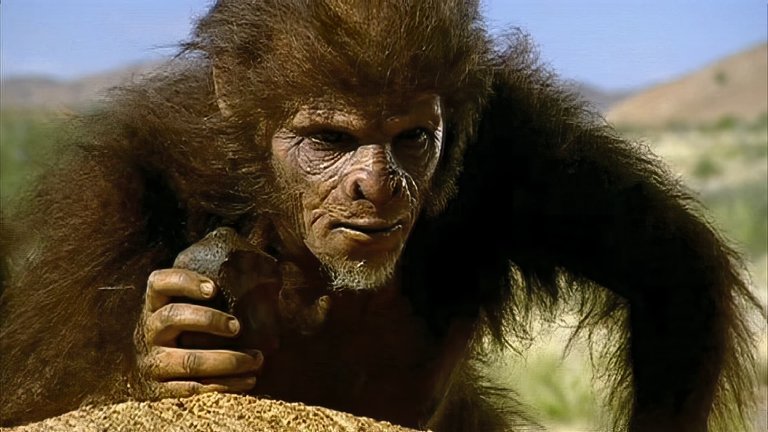Television Review: Walking with Cavemen (2003)

The BBC’s Walking with Dinosaurs (1999) revolutionised natural history programming, merging cutting-edge CGI with palaeontological rigour to resurrect prehistoric worlds. Its success spawned a franchise that expanded with Walking with Beasts (2001), charting mammalian dominance in the Cenozoic era. The third instalment, Walking with Cavemen (2003), occupies an ambiguous space: part sequel, part spinoff. While continuing the franchise’s mission to animate Earth’s distant past, it shifts focus from colossal creatures to humanity’s humble origins—a pivot that, though intellectually ambitious, struggles to replicate the awe of its predecessors.
As a thematic sequel, Walking with Cavemen logically extends Walking with Beasts’ narrative, transitioning from the rise of mammals to the ascendance of their most consequential species: humans. Over four episodes, it traces a 3.2-million-year odyssey, beginning with Australopithecus afarensis (famously embodied by the fossil “Lucy”) and culminating in Homo sapiens’ Ice Age triumph. This evolutionary arc bridges gaps left by Beasts, which touched on hominids briefly in episodes like “Next of Kin.” Yet Cavemen diverges tonally, trading the visceral spectacle of sabre-toothed cats for a slower, cerebral exploration of tool use, social bonding, and cognitive leaps.
Structurally, however, Cavemen functions as a spinoff. Gone is Tim Haines, the franchise’s original producer, whose deft balance of drama and documentary defined earlier series. In his place, presenter Robert Winston—a respected surgeon and broadcaster—guides viewers through the epochs. Winston’s role is dual: part narrator, part on-screen guide, occasionally crouching beside CGI-rendered campfires or gesturing to imagined landscapes. This approach mirrors modern nature documentaries but disrupts the franchise’s signature immersive style, inserting a human intermediary where earlier entries relied on voiceover-led storytelling. The shift risks distancing audiences accustomed to the seamless, narrator-driven worlds of Dinosaurs and Beasts.
The series divides humanity’s prehistory into four chapters. The opener, First Ancestors, introduces Lucy in Ethiopia’s Afar region, emphasising bipedalism’s revolutionary role. Episode two, Blood Brothers, juxtaposes three hominid species 2 million years ago: the nut-cracking Paranthropus boisei, the tool-wielding Homo habilis, and the enigmatic Homo rudolfensis. Here, the documentary excels in illustrating ecological niches, though it simplifies the complex interplay of competition and extinction.
Savage Family (1.5 million–500,000 years ago) follows Homo ergaster’s exodus from Africa, highlighting fire control and proto-language. The finale, Survivors, contrasts Ice Age Europe’s Neanderthals—portrayed as robust but culturally stagnant—with the innovative Homo sapiens, whose symbolic cave art signals unmatched cognitive flexibility. While these episodes condense millennia into digestible arcs, they occasionally lapse into deterministic storytelling, framing Neanderthal extinction as inevitable rather than contingent.
Unlike Beasts, which used CGI to recreate creatures like Australopithecus, Cavemen relies on actors in prosthetic suits. This decision, born of early-2000s technical limitations, yields mixed results. Close-ups of furrowed brows and grasping hands convey nuanced emotion, particularly in Lucy’s maternal interactions. Yet wide shots expose the artifice: hominids move with cautious, human gaits, lacking the primal fluidity CGI might afford. Recycled footage from Beasts—such as mammoth herds—further highlights the disparity, reminding viewers of the franchise’s usual visual grandeur.
The series’ muted reception arguably stems from its subject matter. While Lucy’s story fascinates anthropologists, her small stature and simian features lack the visceral impact of a Tyrannosaurus rex or woolly mammoth. Cavemen’s hominids, though meticulously reconstructed, inhabit a narrative grey zone: neither beast nor human, their struggles for survival—while evolutionarily pivotal—feel abstract compared to the life-or-death hunts of Dinosaurs. The absence of megafauna, save for brief cameos by Deinotherium or Megaloceros, exacerbates this issue, leaving the series feeling insular.
Winston’s presence polarises. Clad in a safari jacket, he addresses the camera like a lecturer, a stylistic departure from Kenneth Branagh’s disembodied gravitas in Beasts. Purists may find his interludes jarring, disrupting the otherwise immersive recreations. Yet his expertise lends authority, particularly when explaining fossil evidence or genetic markers. If his tone occasionally veers into sentimentality—romanticising hominid “family bonds”—it counterbalances the series’ drier academic segments.
Walking with Cavemen remains a curate’s egg. Its commitment to scientific accuracy, from the Laetoli footprints to Neanderthal burial rites, is commendable, offering a primer on human evolution unmatched in mainstream media. However, its hybrid format—part documentary, part presenter-led showcase—dilutes the franchise’s signature magic. While devotees of the Walking with… brand will appreciate its ambition, casual viewers may lament the absence of spectacle. In the end, the series mirrors its subjects: a transitional form, bridging past glories and future possibilities, but not quite the apex of its lineage.
RATING: 6/10 (++)
Blog in Croatian https://draxblog.com
Blog in English https://draxreview.wordpress.com/
InLeo blog https://inleo.io/@drax.leo
Hiveonboard: https://hiveonboard.com?ref=drax
InLeo: https://inleo.io/signup?referral=drax.leo
Rising Star game: https://www.risingstargame.com?referrer=drax
1Inch: https://1inch.exchange/#/r/0x83823d8CCB74F828148258BB4457642124b1328e
BTC donations: 1EWxiMiP6iiG9rger3NuUSd6HByaxQWafG
ETH donations: 0xB305F144323b99e6f8b1d66f5D7DE78B498C32A7
BCH donations: qpvxw0jax79lhmvlgcldkzpqanf03r9cjv8y6gtmk9
I did not know about the existence of this marvel, I saw Walking with Dinosaur some episodes and left it pending to see the rest so Walking with Beasts definitely caught my attention, I have to see it and anotadisimo, what a good suggestion for those who love documentaries and our prehistory as a species besides knowing more of our planet 😎